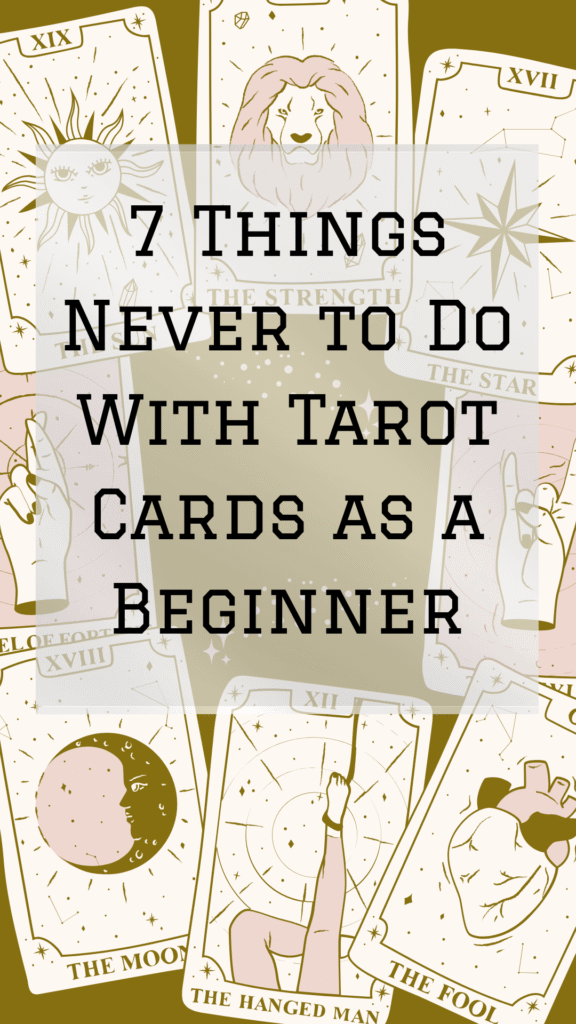
Introduction:
Respect the Cards, Respect the Craft
Starting your tarot journey is both exciting and enlightening. Tarot cards can be powerful tools for self-discovery, intuition building, and spiritual growth. But as with any practice rooted in tradition and symbolism, there are common mistakes beginners often make—usually out of curiosity or misinformation. This guide outlines the top 7 things you should never do with tarot cards when you’re just starting out. These are not rules to scare you, but gentle boundaries to help you connect with your deck respectfully and mindfully.
Tarot is much more than laying out some cards and interpreting pictures. It involves energy, intuition, and connection—not just to the deck, but also to your inner self. Beginners often overlook these subtle layers, eager to get quick answers. But developing a strong tarot practice is like building a relationship. You need patience, time, and care. Whether you’re practicing tarot for personal insight or to one day read for others, avoiding these common missteps will set the stage for deeper clarity, stronger intuition, and lasting respect for the art of divination.
1. Never Treat Tarot Cards as a Toy
Tarot is not a game. While it’s perfectly fine to have fun during your readings, treating tarot cards like a novelty item can weaken your connection to them. They’re tools for insight, not party tricks or props.
Some people buy tarot decks because they’re trendy or visually appealing, but quickly lose interest when they don’t get “magical” results. Tarot requires a certain reverence. It’s not about superstition, but about respecting a practice that people have used for centuries to navigate uncertainty and deepen self-awareness.
Why It Matters: Approach the cards with intention, and they’ll respond with clarity. Treating them like toys can interrupt your ability to form a genuine bond with your deck.
2. Don’t Read Tarot When You’re Emotionally Overwhelmed
Your emotional state deeply impacts the accuracy and usefulness of your tarot readings. If you’re angry, anxious, or emotionally unstable, your energy may cloud the reading. This can lead to misinterpretation and frustration.
For instance, if you’re worried about a breakup and consult your cards obsessively in an emotional spiral, the reading will likely reflect your anxiety rather than offering balanced insight.
Better Approach: Wait until you feel grounded and calm before shuffling the cards. Even a few minutes of deep breathing, a brief walk, or a short meditation can help you reset your energy.
3. Avoid Asking the Same Question Repeatedly
One of the most common beginner mistakes is pulling cards for the same question multiple times. You didn’t like the answer the first time, so you try again, hoping for a different result. This undermines the process and can create confusion.
Tarot isn’t about fortune-telling—it’s a conversation between your intuition and the cards. Constantly repeating questions can blur the message and cause you to lose faith in your readings.
Instead:
Reflect on the original answer or pull clarifying cards for deeper understanding. Accept the response as guidance and give it time to reveal its full meaning.
4. Never Let Just Anyone Handle Your Cards
our tarot deck absorbs energy, including from the people who touch it. Letting others handle your deck—especially those unfamiliar with tarot—can interfere with its energetic balance.
This doesn’t mean you have to be overly protective or fearful. But especially when your deck is new or if you’re building a strong energetic bond with it, it’s important to keep it personal.
What to Do: If someone must touch your cards (like during a reading), cleanse them afterward with smoke (sage, palo santo), sound (bells, singing bowls), or intention (visualizing white light cleansing your deck).
5. Don’t Neglect Learning Card Meanings
Tarot is rich with symbolism. Every color, number, and illustration carries meaning. While intuition plays a huge role, it’s important not to skip the foundational knowledge of each card.
Relying solely on the guidebook or your gut feeling may lead to inconsistent interpretations. Balance is key. Learning traditional meanings adds layers to your readings and helps you trust your interpretations more fully.
Tip: Study one card a day. Use a tarot journal to record insights, patterns, and emotional reactions. Over time, your understanding will deepen naturally.
6. Avoid Using Tarot to Make Major Life Decisions Immediately
It’s tempting to use tarot as a way to get answers about big life events—Should I quit my job? Should I leave this relationship? Should I move to another city?
While tarot can offer perspective, it should not be your only tool for decision-making. Let it be a flashlight, not a GPS. It can illuminate hidden thoughts, emotions, and dynamics—but the final choice is yours.
Best Practice: Use tarot as a mirror, not an absolute authority. Supplement your readings with logic, advice from trusted friends, and practical planning.
7. Don’t Store Your Deck Just Anywhere
Your tarot deck is a sacred tool and should be treated as such. Storing it carelessly on a cluttered table or letting it gather dust in a drawer disrespects the practice and weakens your connection.
Your deck deserves a home that matches its purpose. Some readers use silk cloths to wrap their cards, others place them in wooden boxes or fabric pouches. Choose what feels meaningful to you.
Storage Ideas: Use a special spot on your altar, bookshelf, or nightstand. Keep it clean, dry, and energetically protected. You can even place a crystal like clear quartz or amethyst on top for added cleansing.
Deepening Your Connection with Tarot
As you grow in your tarot journey, you’ll realize it’s as much about connecting with yourself as it is with the cards. The relationship you form with your deck mirrors your own inner world. The more you respect the process, the more accurate and insightful your readings become.
Develop rituals around your readings—light a candle, say a short prayer or affirmation, and take a few grounding breaths. These actions, while small, signal to your subconscious that you’re entering sacred space. Over time, this deepens the trust between you and your cards.
You can also experiment with different spreads (past-present-future, Celtic cross, or custom layouts), work with moon phases, or incorporate astrology and numerology. Tarot is a versatile tool—you’ll find your own rhythm and style with time.
Final Thoughts:
Tarot Is a Journey, Not a Destination
No one becomes a tarot expert overnight. Even readers with decades of experience continue learning and evolving. Mistakes are part of the process, and they offer valuable lessons.
By avoiding the 7 beginner pitfalls listed above, you’ll lay the groundwork for a more respectful, powerful, and authentic tarot practice. Trust yourself, honor the cards, and be open to whatever wisdom they reveal.
Whether you’re pulling a daily card for inspiration or doing deep introspective spreads, know that tarot can be a lifelong companion. It’s here to guide, not control. To empower, not dictate. And most importantly, it’s here to help you grow.
So shuffle the deck with love, cut it with intention, and read with an open heart. The answers you seek are already within you—the cards just help you find them.
